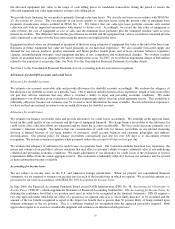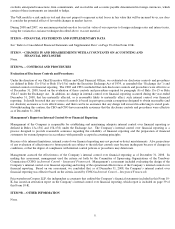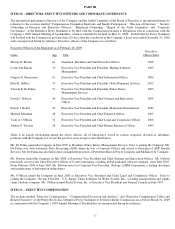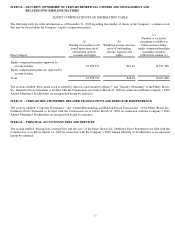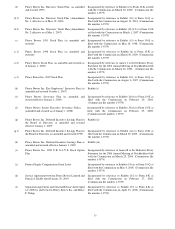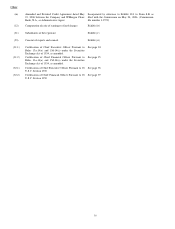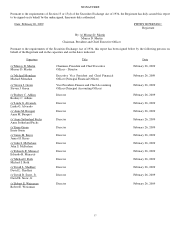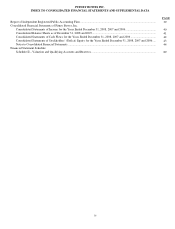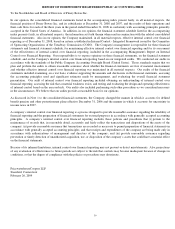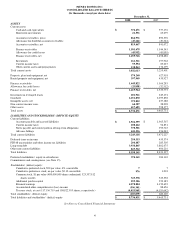Pitney Bowes 2008 Annual Report Download - page 50
Download and view the complete annual report
Please find page 50 of the 2008 Pitney Bowes annual report below. You can navigate through the pages in the report by either clicking on the pages listed below, or by using the keyword search tool below to find specific information within the annual report. 31
excludes anticipated transactions, firm commitments, and receivables and accounts payable denominated in foreign currencies, which
certain of these instruments are intended to hedge.
The VaR model is a risk analysis tool and does not purport to represent actual losses in fair value that will be incurred by us, nor does
it consider the potential effect of favorable changes in market factors.
During 2008 and 2007, our maximum potential one-day loss in fair value of our exposure to foreign exchange rates and interest rates,
using the variance/co-variance technique described above, was not material.
ITEM 8. – FINANCIAL STATEMENTS AND SUPPLEMENTARY DATA
See “Index to Consolidated Financial Statements and Supplemental Data” on Page 38 of this Form 10-K.
ITEM 9. – CHANGES IN AND DISAGREEMENTS WITH ACCOUNTANTS ON ACCOUNTING AND
FINANCIAL DISCLOSURE
None.
ITEM 9A. – CONTROLS AND PROCEDURES
Evaluation of Disclosure Controls and Procedures
Under the direction of our Chief Executive Officer and Chief Financial Officer, we evaluated our disclosure controls and procedures
(as defined in Rule 13a-15(e) or Rule 15a-15(e) under the Securities Exchange Act of 1934, as amended (the “Exchange Act”)) and
internal control over financial reporting. The CEO and CFO concluded that such disclosure controls and procedures were effective as
of December 31, 2008, based on the evaluation of these controls and procedures required by paragraph (b) of Rule 13a-15 or Rule
15d-15 under the Exchange Act. In addition, no change in internal control over financial reporting occurred during the year ended
December 31, 2008, that has materially affected, or is reasonably likely to materially affect, such internal control over financial
reporting. It should be noted that any system of controls is based in part upon certain assumptions designed to obtain reasonable (and
not absolute) assurance as to its effectiveness, and there can be no assurance that any design will succeed in achieving its stated goals.
Notwithstanding this caution, the CEO and CFO have reasonable assurance that the disclosure controls and procedures were effective
as of December 31, 2008.
Management’s Report on Internal Control Over Financial Reporting
Management of the Company is responsible for establishing and maintaining adequate internal control over financial reporting as
defined in Rules 13a-15(f) and 15d-15(f) under the Exchange Act. The Company’s internal control over financial reporting is a
process designed to provide reasonable assurance regarding the reliability of financial reporting and the preparation of financial
statements for external purposes in accordance with generally accepted accounting principles.
Because of its inherent limitations, internal control over financial reporting may not prevent or detect misstatements. Also, projections
of any evaluation of effectiveness to future periods are subject to the risk that controls may become inadequate because of changes in
conditions, or that the degree of compliance with internal control policies or procedures may deteriorate.
Management assessed the effectiveness of the Company’s internal control over financial reporting as of December 31, 2008. In
making this assessment, management used the criteria set forth by the Committee of Sponsoring Organizations of the Treadway
Commission (COSO) in Internal Control - Integrated Framework. Management’s assessment included evaluating the design of the
Company’s internal control over financial reporting and testing of the operational effectiveness of the Company’s internal control over
financial reporting. Based on our assessment, we concluded that, as of December 31, 2008, the Company’s internal control over
financial reporting was effective based on the criteria issued by COSO in Internal Control – Integrated Framework.
PricewaterhouseCoopers LLP, the independent accountants that audited the Company’s financial statements included in this Form 10-
K, has issued an attestation report on the Company’s internal control over financial reporting, which report is included on page 39 of
this Form 10-K.
ITEM 9B. – OTHER INFORMATION
None.





